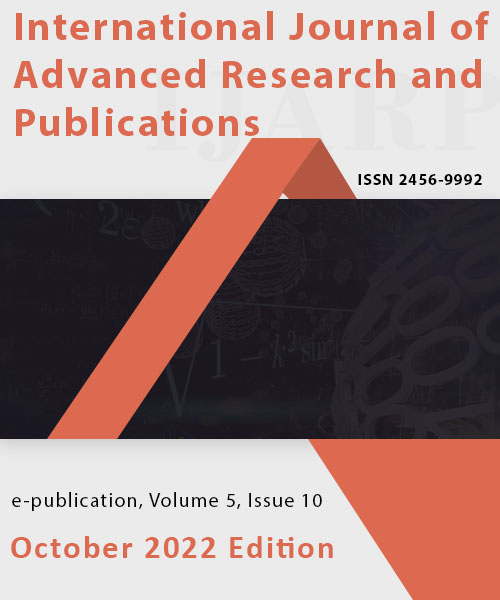Budgetary Control And Financial Performance Of Listed Manufacturing Firms In Kenya: Application Of Liquidity Control
 Volume 5 - Issue 10, October 2022 Edition
Volume 5 - Issue 10, October 2022 Edition
[Download Full Paper]
Author(s)
Harrison Wanje Katana, Margaret Atieno, Silvester Mackton Wanyama
Keywords
Budgetary control, liquidity control, financial performance.
Abstract
In the recent past, listed manufacturing firms had several challenges, including making losses, inability to pay liabilities, and inability to align the actual expenses to the planned despite extensive use of budgetary control measures. Various attempts were made to enhance financial performance of the listed manufacturing firms including government reducing production costs and allocating budget to act as subsidies but still, the problems persist. Therefore, this study looked at how listed manufacturing firms controlled the liquidity to improve financial performance. The purpose of this study was to establish the influence of budgetary control on financial performance of listed manufacturing firms in Kenya. The specific objectives to examine the influence of liquidity control on the financial performance of listed manufacturing firms in Kenya. The study used current ratio, as the measures for liquidity control. The study was anchored on liquidity management theory. The study used a correlational research design and a pragmatic research philosophy. All the eight manufacturing firms listed at Nairobi Securities Exchange (NSE), were targeted. STATA was used to analyze the collected data, producing descriptive and inferential statistics. According to descriptive statistics, the mean values for Return on Assets (ROA), current ratio (CR) was 0.2078. Pearson correlation analysis revealed that CR had a significant positive relationship with ROA, with an r = 0.5952, and p-value of 0.0000. Hausman test was used to choose between fixed and random effect models and the results revealed that random effect regression model was effective, since the hausman had a p-value of 0.0924, greater than 0.05 significant level. The random-effect models showed p-value of 0.000, indicating that the model was appropriate. In addition, the model had an R2 of 0.5610, indicating that budgetary control contributed 56.1% of ROA, while the 43.9% were contributed by other factors not covered by the model. Furthermore, the study showed that liquidity control had a significant influence on financial performance of listed manufacturing firms in Kenya since they had coefficient values of 0.2585, with p-values<0.05, indicating that all coefficient were significant. The findings will benefit the managers and employees of the listed manufacturing firms in assessing performance and future growth. The study recommends that listed manufacturing firms should monitor the liquidity position of the firms to ensure they meet the required level to increase the financial performance and industrial growth.
References
[1] Alali, M. S. (2020). Liquidity Management and Bank Financial Performance in Kuwait. Financial Markets, Institutions and Risks, 4(3), 105-111.
[2] Cline , A. (2018). Pragmatism Philosophy. Journal of Integrated Design and Process Science, 18-32.
[3] Drury, C. (2012). Management and Cost Accounting. Northway: British Library Cataloguing-in-Publication Data.
[4] Ethiedu, J. (2014). Impact of liquidity Control on the Profitability of Selected Canufacturing companies in Nigeria. Journal of business and management horizons, 279-286.
[5] Flaming, N. (1987). Liquidity Management Theory. The Journal of Finance, 379-392.
[6] Freeman, R. E., & Philips, R. A. (2003). Stakeholder theory a libertarian defense. Business Ethics Quarterly,, 12(3), 331-349.
[7] Greenberg, J. (2011). Behavior in organizations (10th editio ed.). Upper Saddle River: Prentice Hall.
[8] Jonick, C. (2017). Principles Financial Accounting. Dahlonega, Georgia: University of North Georgia Press. Retrieved from https://web.ung.edu/media/university-press/Principles-of-Financial-Accounting.pdf?t=1542408454385
[9] Kenya National Bureau of Statistics. (2020). Economic Survey 2020. Nairobi, Kenya: KNBS.
[10] Kothari, C. R., & Garg, G. (2014). Research Methods: Methods and Techniques. New Delhi: New Age International Publishers.
[11] Latham, G. P. (2003). Goal setting: A five-step approach to behavior change. Organizational Dynamics, 309-318.
[12] Mandela, N. M. (2014). The effect of Budgetary control process on firms financial performance: A case study of Nzoia Sugar Company, Kenya. Moi University Repository.
[13] Mbogo, M., Olando, C., & Macharia , J. (2021). Effect of budgeting practices on financial performance of manufacturing small and medium enterprises in Nairobi County, Kenya. Journal of Language, Technology and Enterepreneurship in Africa, 84-110.
[14] Murray, D. (1990). The performance effects of participative budgeting: an integration of Intervening and moderating variables. Behavioral Research in Accounting, 2, 104-123.
[15] Nyabate, J. O. (2015). Effects od Liquidity on the Financial Performance of financial institutions listed in the Nairobi Securities Excenge. University of Nairobi Repository.
[16] Obida, M., & Owolabi, A. (2012). Liquidity Management and Corporate Profitability on Manufacturing Companies Listed on the Nigerian Stock Exchange. International Review of Business Research Papers, 734-741.
[17] Post, J. E., Lawrence, A., & Weber, J. (2002). Business and Society: Corporate Strategy, Public Policy, Ethics. New York. NY: McGraw-Hill.
[18] Rhodes, C. (2020). Manufacturing: statistics and policy. London: House of Common Library.